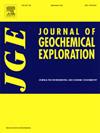Geology of the Nguba Group-hosted Lonshi copper deposit in the Democratic Republic of Congo and exploration implications
IF 3.4
2区 地球科学
Q1 GEOCHEMISTRY & GEOPHYSICS
引用次数: 0
Abstract
Lonshi is a newly discovered copper deposit located in the southeastern region of the Central African Copperbelt in the Democratic Republic of Congo. The deposit is hosted in the Nguba Group of the Katanga Supergroup. This paper analyzes the lithostratigraphy, controlling structures, ore host rock, and mineralization characteristics of the Lonshi deposit. The lithostratigraphy of the Lonshi area is comprised of the Mwashya sandstone of the Roan Group; conglomerate, dolostone, shale, mudstone, and siltstone of the Nguba Group; and conglomerate, pink dolostone, and siltstone of the Kundelungu Group. Geological structures identified within the mining zone encompass N-S and W-E trending folds, NW-trending fault, E-W sinistral shears, and various fractures and veins. The Lonshi deposit exemplifies a characteristic of hydrothermal stratiform mineralization, comprising two main orebodies situated within the Mwale conglomerate (lower orebody) and the underlying Lonshi dolostone (upper orebody). The ore was deposited during three mineralization stages, wherein the first hydrothermal stratigraphically-controlled stage deposited chalcocite 1, bornite, chalcopyrite, and pyrite. The structurally controlled stage 2 is subdivided into chalcocite 2 and bornite of stage 2a, and chalcopyrite, bornite, and native copper of stage 2b. Supergene alteration defining stage 3 resulted in the deposition of chalcocite 3, malachite, cuprite, azurite, and native copper 2. The gangue minerals associated with copper sulfide minerals consist of ankerite, feldspar, quartz, muscovite/sericite, kaersutite, barite, and illite. The sulfide minerals display zonation both vertically and laterally, transitioning from chalcocite to bornite to chalcopyrite to pyrite±sphalerite. Copper sulfide minerals occur as fine- to coarse-grained disseminations within the Nguba conglomerate andshow a replacement texture. The mineralizing fluids at the Lonshi deposit were likely enriched in Fe, Ca, Mg, Si, S, and Cu, with additional Mg contributed from the ore-hosting dolostone and Co and K from the ore-hosting conglomerate.
The Nguba Group at the Lonshi copper deposit shows distinct lithologies composed of black- to light-gray conglomerates and dolostone, which provide valuable insights for the discovery of new deposits. The observed mineral zoning, hydrothermal alteration, and multi-stage mineralizing events suggest favorable conditions for copper deposition. Targeting similar stratigraphic settings and alteration signatures in the vicinity of the Lonshi mine and in the Nguba Group could enhance the likelihood of discovering new deposits, particularly in areas exhibiting similar geological characteristics and structural features.

求助全文
约1分钟内获得全文
求助全文
来源期刊

Journal of Geochemical Exploration
地学-地球化学与地球物理
CiteScore
7.40
自引率
7.70%
发文量
148
审稿时长
8.1 months
期刊介绍:
Journal of Geochemical Exploration is mostly dedicated to publication of original studies in exploration and environmental geochemistry and related topics.
Contributions considered of prevalent interest for the journal include researches based on the application of innovative methods to:
define the genesis and the evolution of mineral deposits including transfer of elements in large-scale mineralized areas.
analyze complex systems at the boundaries between bio-geochemistry, metal transport and mineral accumulation.
evaluate effects of historical mining activities on the surface environment.
trace pollutant sources and define their fate and transport models in the near-surface and surface environments involving solid, fluid and aerial matrices.
assess and quantify natural and technogenic radioactivity in the environment.
determine geochemical anomalies and set baseline reference values using compositional data analysis, multivariate statistics and geo-spatial analysis.
assess the impacts of anthropogenic contamination on ecosystems and human health at local and regional scale to prioritize and classify risks through deterministic and stochastic approaches.
Papers dedicated to the presentation of newly developed methods in analytical geochemistry to be applied in the field or in laboratory are also within the topics of interest for the journal.
 求助内容:
求助内容: 应助结果提醒方式:
应助结果提醒方式:


